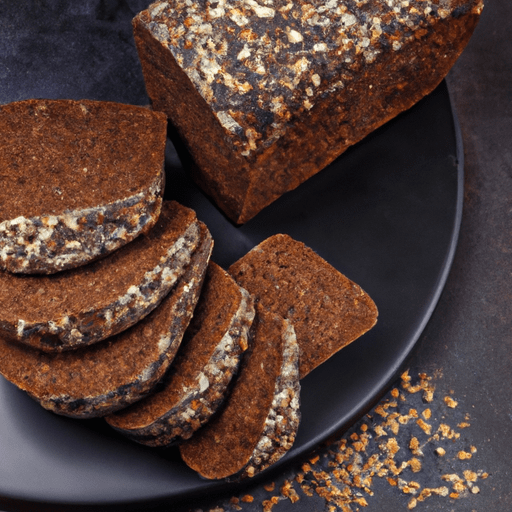Exploring the Rich Delights of Pumpernickel Bread
Pumpernickel bread is a dark and hearty rye bread that carries a rich history and an unmistakable flavor. With its deep brown color, dense texture, and unique taste, this beloved bread has become a staple in many culinary traditions. In this blog post, we will unravel the mysteries of pumpernickel bread, exploring its origins, nutritional benefits, and versatile uses in cooking.
Origins and History
Pumpernickel bread traces its roots back to Germany, where it originated in the Westphalia region. The name itself is a combination of two German words: “pumpern,” denoting flatulence, and “Nickel,” a nickname for a goblin or devil. This whimsical name reflects an interesting historical tale: it is believed that the name was given to the bread due to its reputation for being difficult to digest, leading to gassy consequences.
Traditionally, pumpernickel bread was made from coarsely ground rye flour, with the addition of sourdough starter or natural yeast. The dough was then baked at a low temperature for several hours, resulting in its characteristic dark color, dense texture, and a deeply flavorful taste.
Unveiling the Taste and Texture
One of the defining features of pumpernickel bread is its distinctive taste. The flavor profile can be described as earthy, slightly sweet, and subtly tangy. The long, slow baking process caramelizes the natural sugars in the rye, giving the bread a hint of sweetness and a delightful roasted aroma.
In terms of texture, pumpernickel bread is pleasantly dense, moist, and chewy. Its firmness allows it to hold up well to various spreads and toppings, making it a popular choice for sandwiches and canapés.
Nutritional Benefits
Pumpernickel bread not only tantalizes the taste buds but also offers several nutritional benefits. Rye, the main ingredient, is packed with dietary fiber, vitamins, and essential minerals. Its high fiber content aids digestion, promotes satiety, and helps regulate blood sugar levels. Rye is also known for its lower gluten content compared to traditional wheat, making it a suitable option for individuals with mild gluten sensitivities.
Additionally, pumpernickel bread contains a good amount of iron, magnesium, and B-vitamins, all of which contribute to a balanced and healthy diet. Its nutritional profile makes it an excellent choice for those looking to add more wholesome and nutrient-dense foods to their daily meals.
Culinary Uses
Pumpernickel bread offers a wide range of culinary possibilities. Its robust flavor pairs well with both sweet and savory ingredients, making it a versatile addition to your cooking repertoire.
Sandwiches: Pumpernickel bread adds a delightful depth of flavor to any sandwich. It complements classic deli meats like roast beef, pastrami, or smoked turkey. For a vegetarian twist, try it with creamy avocado, crisp cucumber, and tangy goat cheese.
Dips and Spreads: The dense texture of pumpernickel bread makes it ideal for scooping up creamy dips or spreading with delectable toppings. Hummus, tzatziki, or smoked salmon spread are excellent choices to enhance its taste.
Canapés and Appetizers: Cut into bite-sized pieces, pumpernickel bread can serve as a sturdy base for canapés and appetizers. Top it with a dollop of crab salad, smoked salmon, or caramelized onion jam for a crowd-pleasing treat.
Bread Bowls: Hollowed-out pumpernickel loaves can be transformed into edible bread bowls. Fill them with indulgent dips, soups, or stews to create a visually stunning and delicious centerpiece for gatherings.
Adding Pumpernickel Bread to Your Culinary Repertoire
With its rich flavor, unique characteristics, and numerous culinary uses, pumpernickel bread is a worthy addition to any kitchen. Whether you’re experimenting with new sandwich creations, exploring creative dips and spreads, or simply indulging in its intense taste, pumpernickel bread is sure to delight your taste buds and impress your guests.
So, why not embark on a culinary adventure, slice into a fresh loaf of pumpernickel bread, and savor every bite? Your foray into the world of this delectable dark rye bread will surely be an unforgettable journey for your palate.
Pumpernickel Bread
Origin: Pumpernickel bread is a traditional German bread that originated in Westphalia, a region in western Germany. It dates back to the Middle Ages and was originally made with rye flour and coarse, whole grains.
Common Uses: Pumpernickel bread is commonly used for sandwiches, especially for deli-style meats and cheeses. It is also enjoyed on its own, often with butter or spreads. The dense texture and rich flavor of pumpernickel make it a popular choice for hearty recipes like bread bowls or stuffing.
Nutritional Benefits: Pumpernickel bread is a good source of dietary fiber, which aids in digestion and helps maintain a healthy digestive system. It also contains essential minerals such as iron, magnesium, and selenium. Pumpernickel bread often contains whole rye flour, which is known for its lower glycemic index compared to white bread, meaning it can help maintain more stable blood sugar levels.
Unique Properties and Historical Significance: Pumpernickel bread is typically made from coarsely ground whole rye berries or rye meal. Its distinctive deep brown color comes from the long, slow baking process, often lasting up to 24 hours, which involves low temperatures and steam. This slow baking process contributes to the dense texture and distinct flavor of pumpernickel bread. Traditional pumpernickel bread was traditionally baked in stone ovens and its name is derived from the German words “pumpern” (to “break wind”) and “Nickel” (a hypocoristic form of the name “Nicholas”), possibly referring to its reputation for causing flatulence in earlier times.




Use the share button below if you liked it.
It makes me smile, when I see it.